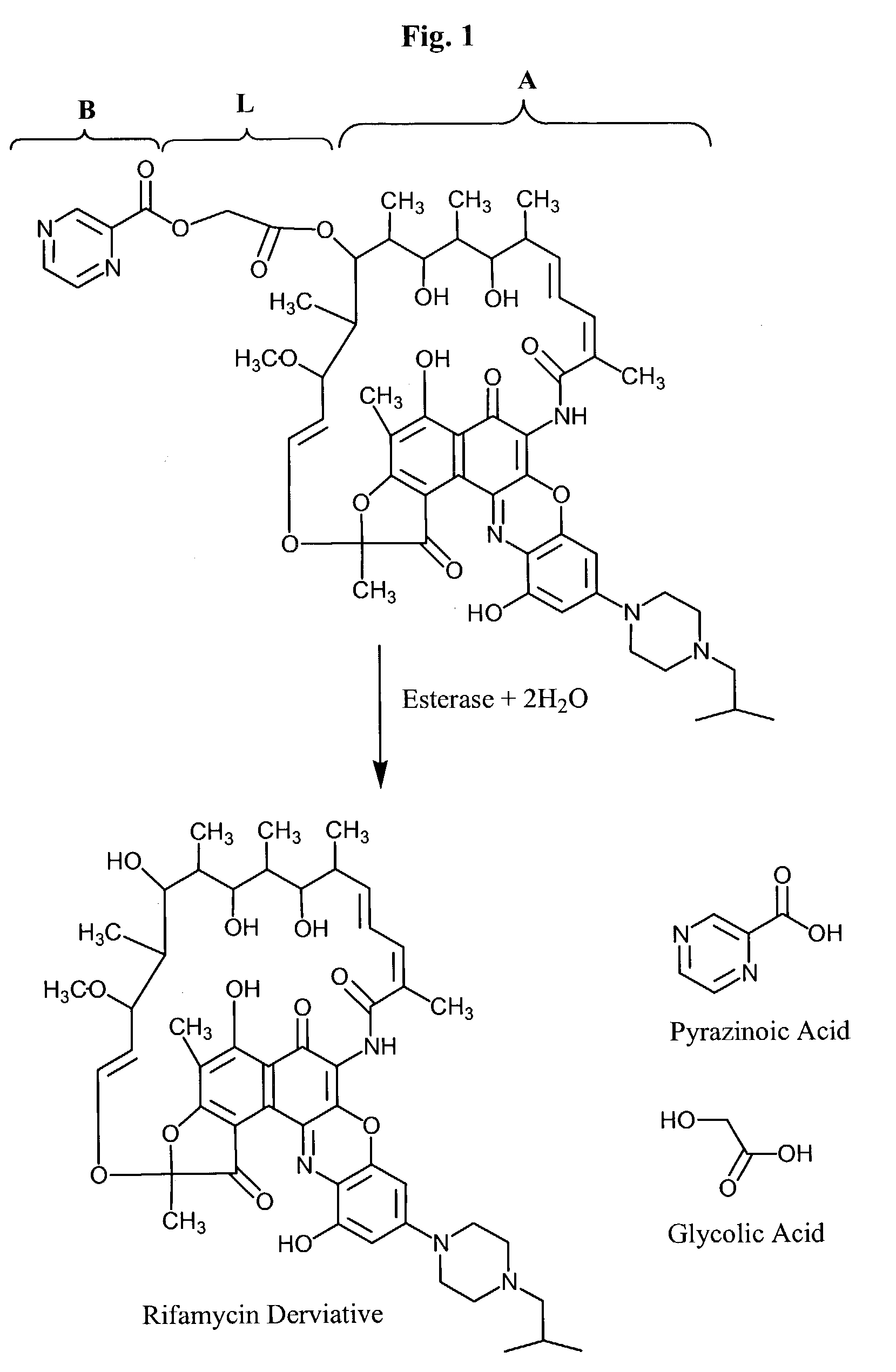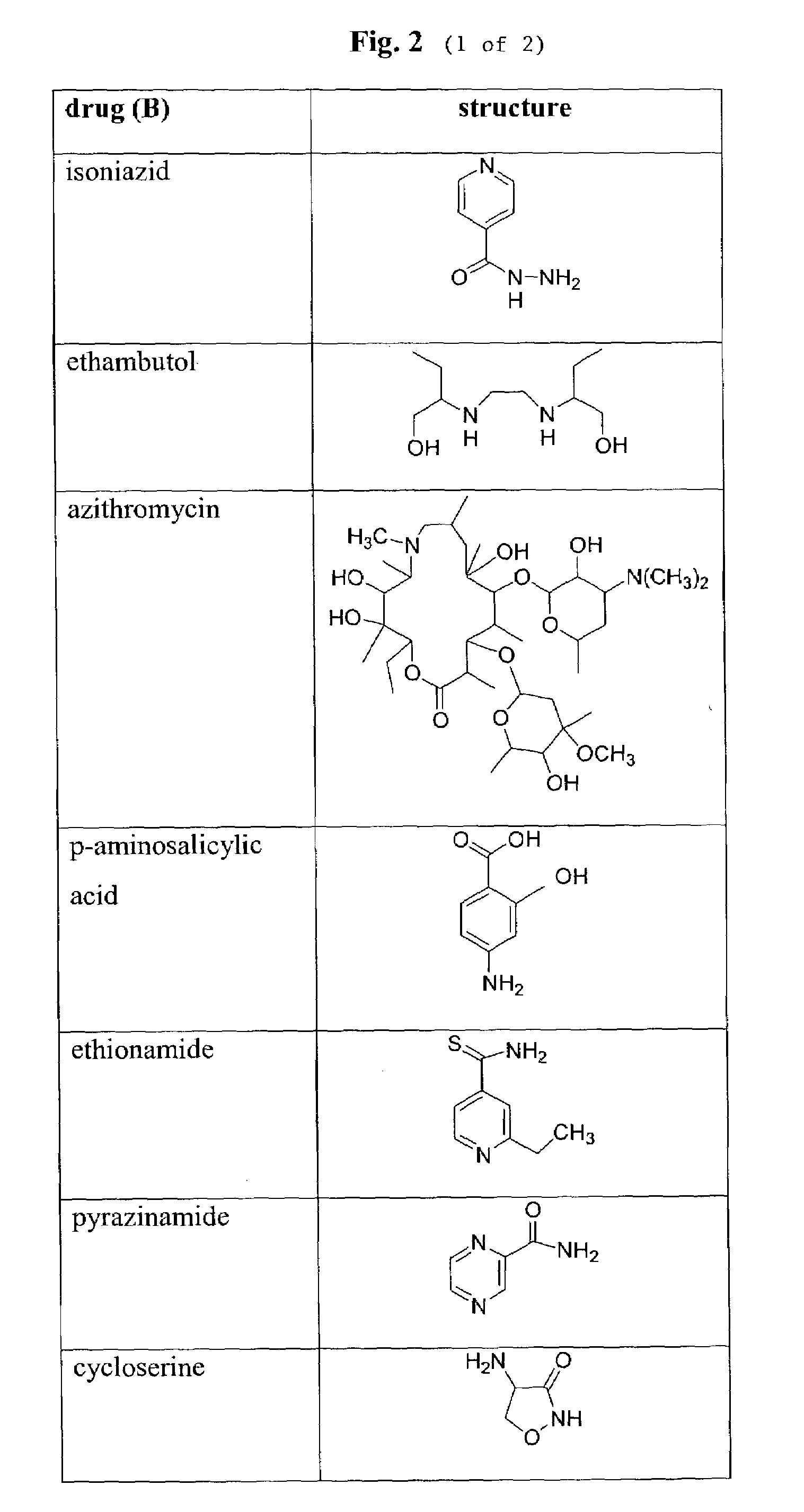Targeted therapeutics and uses thereof
a technology of targeted therapeutics and therapeutic components, applied in the field of targeted therapeutics, can solve the problems of few effective treatments, and achieve the effects of improving localization, facilitating biodistribution, and optimal activity of these latter drugs
- Summary
- Abstract
- Description
- Claims
- Application Information
AI Technical Summary
Benefits of technology
Problems solved by technology
Method used
Image
Examples
example 1
Protection and Deprotection of Reactive Groups
[0168](A)—(L)—(B) compounds can be prepared by selective protection and deprotection of alcohols, amines, sulfhydryls and carboxylic acid functional groups of rifamycin derivative (A), linker (L), and drug (B). For example, commonly used protecting groups for amines include carbamates, such as tert-butyl, benzyl, 2,2,2 -trichloroethyl, 2-trimethylsilylethyl, 9-fluorenylmethyl, allyl, and m-nitrophenyl. Other commonly used protecting groups for amines include amides, such as formamides, acetamides, trifluoroacetamides, sulfonamides, trifluoromethanesulfonyl amides, trimethylsilylethanesulfonamides, and tert-butylsulfonyl amides. Examples of commonly used protecting groups for carboxylic acids include esters, such as methyl, ethyl, tert-butyl, 9-fluorenylmethyl, 2-(trimethylsilyl)ethoxy methyl, benzyl, diphenylmethyl, O-nitrobenzyl, ortho-esters, and halo-esters. Examples of commonly used protecting groups for alcohols include ethers, such...
example 2
Synthesis of 30-hydroxy and 32-hydroxy Precursor (A) Compounds
[0172]
[0173]The selective oxidation of the 30 and 32 positions of Rifalazil from H to OH is shown in reaction scheme 1. This transformation can be achieved by enzymatic oxidation using the P450 enzyme CYP3A4 (Research Diagnostics, Inc., product number RDI-CYP3A4). Either the commercially available enzyme can be used or rifamycin derivatives can be incubated in liver microsomes as described in Mae et al., Xenobiotica, 30:565, 2000. When the latter method is used, inhibitors of B-esterase, such as diisopropylfluorophosphate, diethyl p-nitrophenylphosphate, or eserine, can be added to prevent enzymatic deacetylation of the rifamycin derivative. 30-Hydroxy Rifalizil and 32-hydroxy Rifalazil can be separated using the hplc techniques described in Mae et al., Xenobiotica, 30(6):565, 2000.
[0174]Selective protection of the primary alcohol produced by the enzymatic oxidation of (A) as shown in reaction scheme 1, can be accomplishe...
example 3
Synthesis of 36-deacetylated Precursor (A) Compounds
[0177]
[0178]The deacetylation of (A), where R1 is converted from acetyl to H is shown in reaction scheme 2. The hydroxyls of (A) can be protected as described in Example 1. Protecting groups are chosen that are not removed during the deacetylation step, such as methoxymethyl ethers, methoxyethoxymethyl ethers, benzyloxymethyl ethers, or any other protecting group compatible with strong bases or nucleophiles. After protection of the hydroxyl groups, the acetyl group can be removed under any one of several conditions known in the art including: KCN / EtOH / reflux, K2CO3 / MeOH / reflux, NH3 / MeOH, LiOH / THF / H2O, or enzymatic hydrolysis (e.g., lipase). A method for deacetylating rifamycin S is disclosed by U.S. Pat. No. 4,188,321, hereby incorporated by reference. Hydroxy protected 36-deacetylated rifamycin derivatives have the formula LV, wherein ring G is defined as in formula II.
PUM
| Property | Measurement | Unit |
|---|---|---|
| Biological properties | aaaaa | aaaaa |
Abstract
Description
Claims
Application Information
 Login to View More
Login to View More - R&D
- Intellectual Property
- Life Sciences
- Materials
- Tech Scout
- Unparalleled Data Quality
- Higher Quality Content
- 60% Fewer Hallucinations
Browse by: Latest US Patents, China's latest patents, Technical Efficacy Thesaurus, Application Domain, Technology Topic, Popular Technical Reports.
© 2025 PatSnap. All rights reserved.Legal|Privacy policy|Modern Slavery Act Transparency Statement|Sitemap|About US| Contact US: help@patsnap.com



